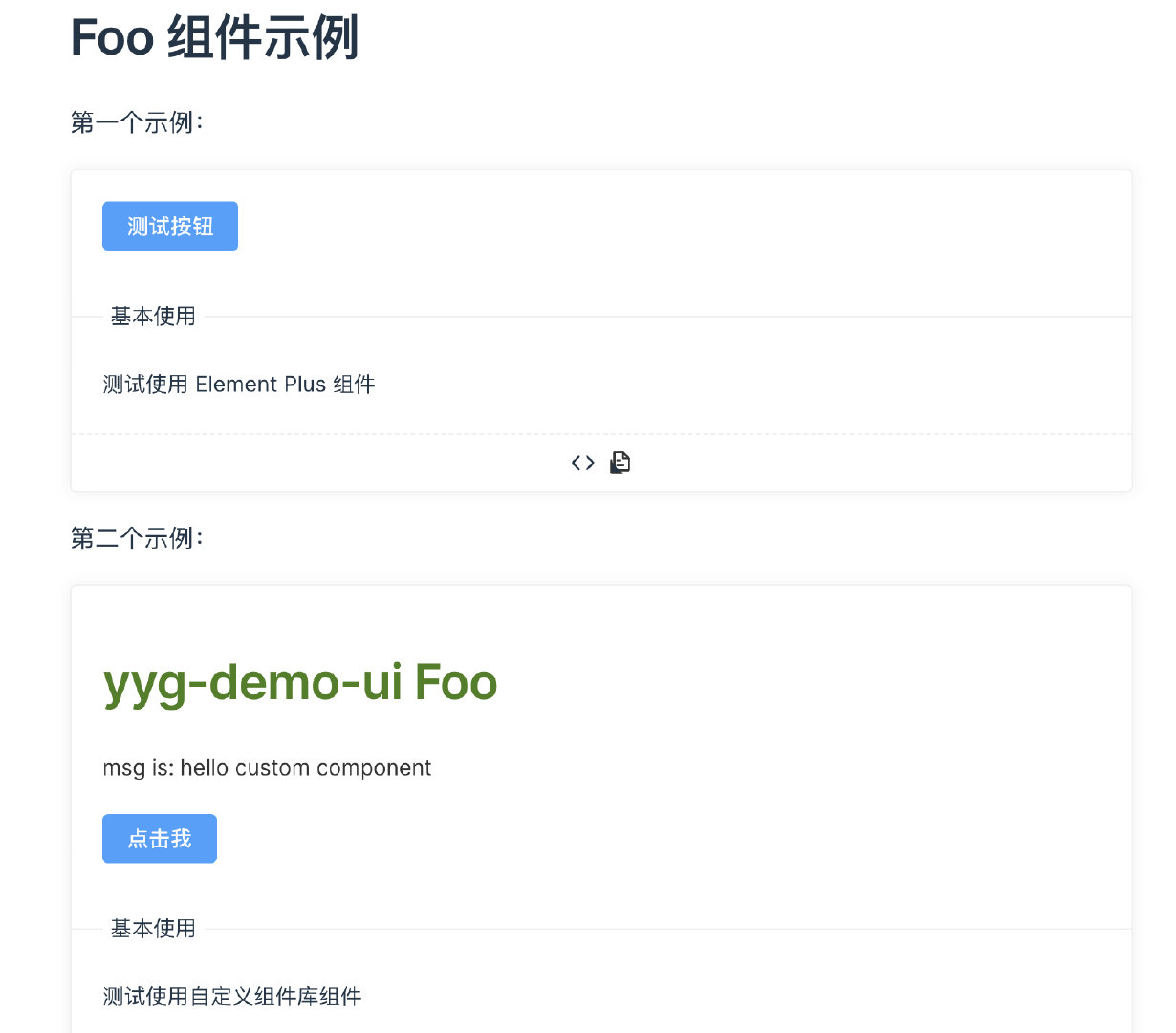- A+
该系列已更新文章:
分享一个实用的 vite + vue3 组件库脚手架工具,提升开发效率
开箱即用 yyg-cli 脚手架:快速创建 vue3 组件库和vue3 全家桶项目
Vue3 企业级优雅实战 - 组件库框架 - 1 搭建 pnpm monorepo
Vue3 企业级优雅实战 - 组件库框架 - 2 初始化 workspace-root
Vue3 企业级优雅实战 - 组件库框架 - 3 搭建组件库开发环境
Vue3 企业级优雅实战 - 组件库框架 - 4 组件库的 CSS 架构
Vue3 企业级优雅实战 - 组件库框架 - 5 组件库通用工具包
Vue3 企业级优雅实战 - 组件库框架 - 6 搭建example环境
前面完成了组件库的开发环境搭建和 example,咱们可以在 example 中通过业务驱动组件的开发和完善。但组件库开发的目的是给其他开发人员使用,这时候就需要通过文档来展示组件库的使用以及各个组件的 API、方法、插槽等。本文在前面文章的基础上继续实现组件库文档的开发和构建。组价库的文档咱们使用 vitepress 来实现,在之前的文章《vitepress搭建组件库文档》已经详细介绍了 vitepress 1.0 的使用,该文章中谈到的内容本文就快速略过。
1 搭建组件库文档环境
1.1 初始化工程
前面在工程根目录创建 docs 目录,在命令行中进入 docs 目录,使用 pnpm 初始化:
pnpm init 安装 vitepress 为开发依赖:
pnpm install vitepress -D 修改 package.json 文件的 name,并添加 scripts:
{ "name": "@yyg-demo-ui/docs", "version": "1.0.0", "description": "", "main": "index.js", "scripts": { "dev": "vitepress dev", "build": "vitepress build", "serve": "vitepress serve" }, "keywords": [], "author": "程序员优雅哥", "license": "ISC", "devDependencies": { "vitepress": "1.0.0-alpha.28" } } 1.2 创建目录及文件
在 docs 目录下创建 .vitepress、public、components、demos、guide,分别存放 vitepress 配置文件、公共资源目录、组件文档描述、文档中的 demo、组价库的其他说明文档。放一个 logo.png 图片到 public 目录下。
继续在 docs 目录下依次创建下列文件:
- 组件库首页 index.md:
--- layout: home title: YYG-DEMO-UI editLink: true lastUpdated: true hero: name: yyg-demo-ui text: YYG Vue3企业级中后台组件库 tagline: 组件库描述 / SLOGAN image: src: /logo.png alt: yyg-admin-ui actions: - theme: brand text: 快速开始 link: /guide/ - theme: alt text: 组件 link: /components/foo features: - icon: ? title: 功能/特点 1 details: 功能/特点 1 具体描述信息。 - icon: ? title: 功能/特点 2 details: 功能/特点 2 具体描述信息。 - icon: ✈️ title: 功能/特点 3。 details: 功能/特点 3 具体描述信息。 --- - 组件库菜单 components.ts :
export const components = [ { text: 'Foo 组件示例', link: '/components/foo' } ] // end 在 guide 目录下分别创建 index.md 和 quickstart.md:
- guide/index.md:
# 组件库介绍 yyg-demo-ui YYG Vue3企业级中后台组件库 - guide/quickstart.md:
# 快速开始 xxxxxx ## 用法 全局安装组件库 在 components 目录下创建示例组件的说明文档 foo.md:
# Foo 组件示例 1.3 添加插件并配置 vitepress
- 安装 vitepress 中预览组件的插件:
pnpm add @vitepress-demo-preview/component @vitepress-demo-preview/plugin - 在 .vitepress 目录下创建 config.ts:
import { DefaultTheme, defineConfig } from 'vitepress' import { componentPreview, containerPreview } from '@vitepress-demo-preview/plugin' import { components } from '../components' const nav: DefaultTheme.NavItem[] = [ { text: '指南', link: '/guide/' }, { text: '组件', link: '/components/foo' } ] const sidebar: DefaultTheme.Sidebar = { '/guide': [ { text: '指南', items: [ { text: '组件库介绍', link: '/guide/' }, { text: '快速开始', link: '/guide/quickstart' }, ] } ], '/components': [{ items: [ ...components ] }] } export default defineConfig({ title: 'yyg-admin-ui', description: 'YYG Vue3企业级中后台组件库', lang: 'cn-ZH', base: '/', lastUpdated: true, themeConfig: { logo: '/logo.png', siteTitle: 'yyg-admin-ui', outline: 3, socialLinks: [ { icon: 'github', link: 'https://github.com/vuejs/vitepress' } ], nav, sidebar }, markdown: { theme: { light: 'vitesse-light', dark: 'vitesse-dark' }, lineNumbers: true, config(md) { md.use(componentPreview) md.use(containerPreview) } } }) - 在 .vitepress 目录下创建 theme 目录,并在 theme 中创建 index.ts
import DefaultTheme from 'vitepress/theme' import { AntDesignContainer } from '@vitepress-demo-preview/component' import '@vitepress-demo-preview/component/dist/style.css' import { EnhanceAppContext } from 'vitepress' export default { ...DefaultTheme, enhanceApp(ctx: EnhanceAppContext) { ctx.app.component('demo-preview', AntDesignContainer) } } 此时组件库的文档结构就搭建好了,可以在 docs 目录下执行 pnpm run dev,测试服务是否能正常启动,页面是否正常显示。
2 编写组件的文档
上一步已经引入了用于展示组件 demo 的插件,这一步就简单了。
2.1 安装 element plus 和组件库
- 在 docs 目录下安装依赖:
pnpm install element-plus pnpm install @yyg-demo-ui/yyg-demo-ui - 在 .vitepress/theme/index.ts 中引入组件库:
... import ElementPlus from 'element-plus' import 'element-plus/dist/index.css' import YygDemoUi from '@yyg-demo-ui/yyg-demo-ui' ... export default { ...DefaultTheme, enhanceApp(ctx: EnhanceAppContext) { ctx.app.use(ElementPlus) ctx.app.use(YygDemoUi) ctx.app.component('demo-preview', AntDesignContainer) } } 2.2 编写demo
在 docs/demos 目录下创建子目录 foo,在 foo 目录下创建两个组件:
foo-1.vue:
<template> <el-button type="primary">测试按钮</el-button> </template> foo-2.vue:
<template> <yyg-foo :msg="msg"></yyg-foo> </template> <script lang="ts" setup> import { ref } from 'vue' const msg = ref('hello custom component') </script> 2.3 vite 配置文件
在 docs 目录下创建 vite 的配置文件 vite.config.ts,该文件主要配置开发端口和 jsx 插件:
import { defineConfig } from 'vite' import VueJsx from '@vitejs/plugin-vue-jsx' export default defineConfig({ plugins: [ VueJsx() ], server: { port: 3100 } }) 2.4 在组件库文档中展示 demo
在 docs/components/foo.md 文件中展示上面两个 demo:
# Foo 组件示例 第一个示例: <preview path="../demos/foo/foo-1.vue" title="基本使用" description="测试使用 Element Plus 组件"></preview> 第二个示例: <preview path="../demos/foo/foo-2.vue" title="基本使用" description="测试使用自定义组件库组件"></preview> ## 组件介绍 3 运行组件库文档
3.1 本地开发
pnpm run dev 访问 http://localhost:3100/components/foo.html,可以看到 foo 组件的说明文档:

3.2 打包构建
- 打包组件库文档:
pnpm run build 打包后的文档位于:docs/.vitepress/dist 中。
- 预览打包后的结果:
pnpm run serve 预览的效果与本地启动服务的效果一致。
到此咱们已经完成了组件库文档的开发环境搭建和打包构建,下一篇文章将分享加速器 —— 创建新组建的脚手架 cli 的开发。
感谢你阅读本文,如果本文给了你一点点帮助或者启发,还请三连支持一下,点赞、关注、收藏,程序员优雅哥会持续与大家分享更多干货




